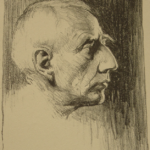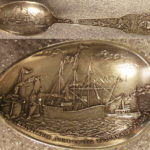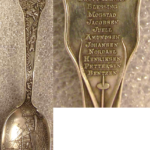Roald Amundsen
Explorer
Modern
Quick Facts:
He led the first expedition to reach the South Pole and was the first person to successfully traverse the Northwest Passage.
Introduction
Roald Amundsen, nicknamed “The Last of the Vikings” was an Arctic explorer, and the first man to reach the South Pole in 1911. A natural explorer, Amundsen was also the first to successfully navigate the Northwest Passage, and reach the North Pole by flight.
Biography
Early Life
The youngest of four brothers, Roald Engeberth Garvning Amundsen, was born July 16, 1872 in the Norway capital of Christiania, present day Oslo. He was the fourth son of Jens Engeberth Amundsen, a wealthy shipping business tycoon. While Amundsen received the best education money could buy, he did not particularly care for school and would often receive barely passing grades. But it was in school that Amundsen would read of the adventures of John Franklin and his expedition to the Northwest Passage.1 This began Amundsen’s fascination for polar exploration.
In 1890, Roald enrolled in the Royal Norwegian Frederick University of Christiania to study medicine, per his mother’s wishes. But instead of focusing on his studies, he began training his skills in skiing, cold weather conditioning, and seafaring. After his mother’s death in 1893, he quit school. In the summer of 1894, he signed onto a commercial sealing ship to further prepare himself for northern weather, gain practical skills, and increase his sailing experience.2 His adventure on the Belgian research vessel Belgica in 1896 was his first real polar expedition. When the ship got trapped in ice, the expedition party was forced to spend winter in extremely harsh conditions. But Amundsen used his skills to hunt for fresh food, and proved himself a capable explorer. This was perhaps one of the most important experiences that would lead him to becoming an Arctic explorer.
Voyages
Principal Voyage
Amundsen’s main voyage to the South Pole began June 6, 1910, aboard the ship Fram. His original plan was to be the first to reach and explore the North Pole. However, when word reached Amundsen that both Robert Peary and Frederick Cook had already claimed to have reached the North Pole, Amundsen changed course and headed for the South Pole. But British explorer, Robert Falcon Scott, was also intent on being the first to reach the South Pole. It became a race for the two men. By January 1911, Amundsen had set up a base camp on the continent of Antarctica, which he named Framheim – “Home of Fram.”
Amundsen had trouble early on when he decided to travel toward the South Pole at the beginning of September instead of November. During the venture, the weather turned for the worse, and the cold winds battered the men. However, the expedition was well prepared, and they were able to continue on. On December 14, 1911, Amundsen had reached the South Pole, and he named the area King Haakon VII’s Plateau.3 Preparation and smart decisions such as using sled dogs instead of ponies, helped him achieve what he had set out to accomplish.
Subsequent Voyages
Amundsen is most famously remembered for his voyage to the South Pole. However, he had gained international celebrity beforehand, as being the first to navigate the Northwest Passage in 1906. Aboard the ship Gjoa, Amundsen and his crew of six men made their way around the icy waters of Greenland, Canada, and Alaska. During his travels through the Northwest Passage, Amundsen came in contact with the native Inuit people of the region. It was from them he learned many of the polar survival skills he would use later on his 1910 expedition to the South Pole.4 Amundsen’s last great expedition would not be in the sea but by air. In 1926 Amundsen, along with fellow explorers Lincoln Ellsworth and Umberto Nobile, flew the airship Norge to the North Pole. This became the first crossing of the Arctic Basin by air.5
Later Years and Death
After his return, his expedition partner Nobile made claims that Amundsen had little to do with the expedition itself. Amundsen would spend the next two years disputing these allegations. Wanting to prove he did not need Amundsen for an expedition in North, on May 26, 1928, Nobile flew the airship Italia toward the North Pole. He was stopped short of his goal when his airship crashed just outside Spitsbergen.6 Amundsen, jumping at that chance for one last polar adventure, answered the call to rescue his former crew mate. On June 18, 1928, Amundsen boarded the rescue plane to set out and find Nobile. His plane flew into a dense fog, and radio contact went silent moments after. Amundsen was never seen or heard from again.
Legacy
Roald Amundsen is remembered as one of the greatest polar explorers of all time. During what is now called the “Heroic Age of Antarctic Exploration” Amundsen’s contributions are among the top listed. He was the first man to reach the South Pole, first to navigate the Northwest Passage, and first to fly to the North Pole. Tales of his amazing adventures are still told and written about to this day.
Images
- Lithograph portrait of a charcoal sketch of Roald Amundsen. Profile facing left. (Credit: The Mariners’ Museum Catalog# 2008.0029.000003)
- Souvenir Spoon: Front Bowl – In the bowl appears a view of Nansen’s exploration ship the Fram encircled by small sailing craft, a tug and a steamer. Below this is the inscription: CHRISTIANA, JUNE 24, 1893, RETURN SEPT. 9, 1896. (Credit: The Mariners’ Museum Catalog# 1948.0126.000001)
- Souvenir Spoon: Back Handle – On the handle appears a marine scene, possibly depicting the land of the midnight sun. Under this is the following: NORTH POLE EXPEDITION, CAPT. SVERDRUP, SCOTT-HANSEN, BLESSING, MOGSTAD, JACOBSEN, JUELL, AMUNDSEN, JOHANSEN, NORDAHL, HENRIKSEN, PETTERSEN, BENTZEN, under the names are a pair of crossed skis and boots. (Credit The Mariners’ Museum Catalog# 1948.0126.000001)
Endnotes
- Stephen R. Bown, The Last Viking: The Life of Roald Amundsen (Boston, Massachusetts: DA CAPO PRESS, 2012), 7.
- Bown, The Last Viking, 14.
- Richard Sale, Polar Reaches: The History of Arctic and Antarctic Exploration (Seattle, Washington: The Mountaineers Books, 2002), 188.
- Beau Riffenburgh, Polar Exploration: The Royal Geographical Society (London: Carlton Books Limited, 2010), 40.
- Riffenburgh, Polar Exploration, 56.
- Bown, The Last Viking, 319.




